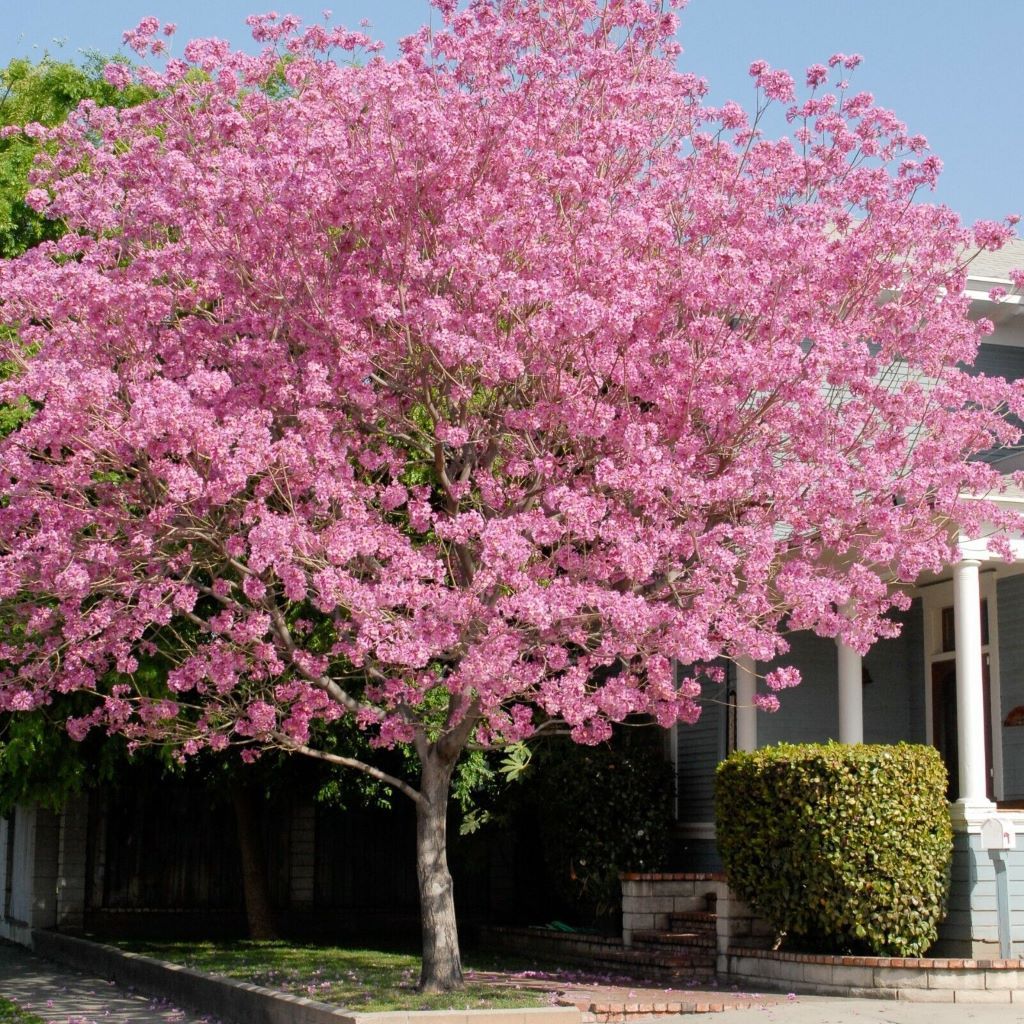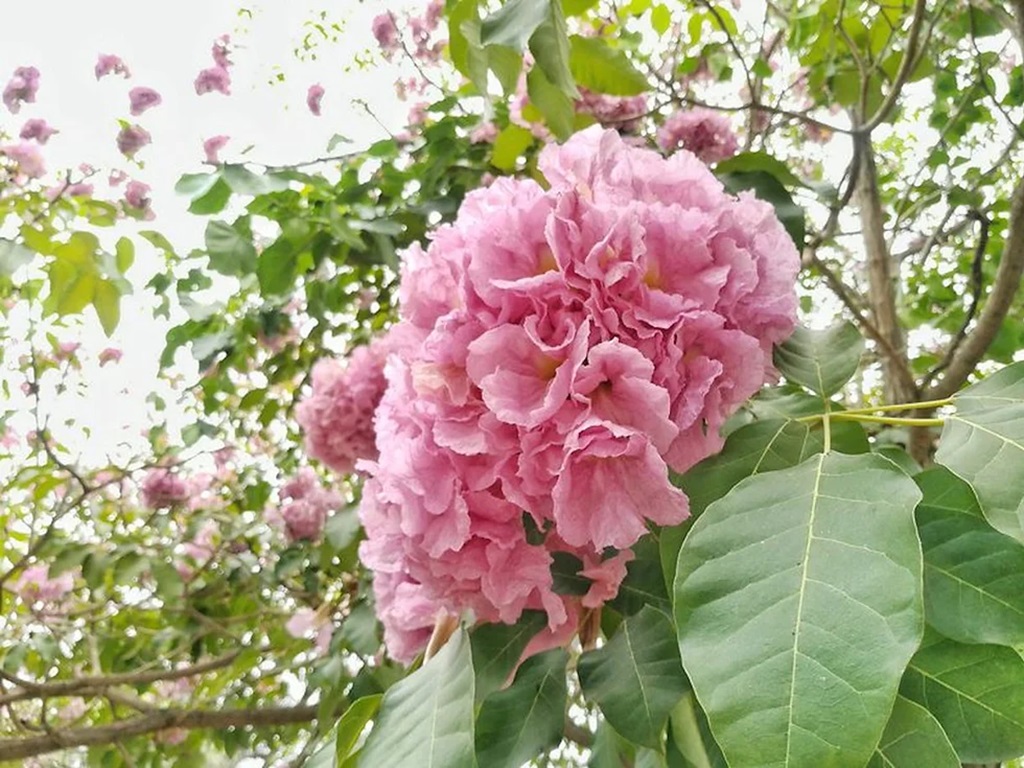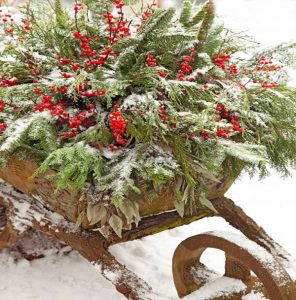
With its vibrant pink flowers and fast growth rate, the pink trumpet tree (Tabebuia impetiginosa) is an attractive and valuable addition to landscapes across the southern United States. Though native to South America, this tree thrives in warm climates and can be found in many yards and parks from Florida to California.
Beyond its visual appeal, the pink trumpet tree has a variety of applications that make it a versatile and valuable plant. Keep reading to learn all about this eye-catching tree and why you may want to add it to your outdoor space.
An Overview of the Pink Trumpet Tree

Several common names, including pink poui, pink tabebuia, and pink trumpet tree, are known as the pink trumpet tree. It belongs to the Bignoniaceae family of flowering plants.
This deciduous tree proliferates when young, adding several feet of height each year until maturity. The average mature height ranges from 20-40 feet tall with an almost equal spread. The canopy casts light to medium shade below.
One of the pink trumpet tree’s most striking features is its clusters of vibrant pink trumpet-shaped blossoms. These blooms appear in spring, usually March or April, just as the leaves emerge. The flowers attract hummingbirds and other pollinators to the garden.
The leaves themselves are green and pinnately compound. Each leaf has 5-11 oval leaflets measuring 2-5 inches long. The foliage turns yellow and drops in winter, leaving the tree bare until the new spring grows.
So, in summary, here are some critical facts about the pink trumpet tree:
- Originates from South America
- Thrives in warm climates
- Features clusters of bright pink trumpet-shaped flowers in spring
- Attracts pollinators like hummingbirds
- Proliferates when young, reaching mature heights of 20-40 feet
- It has pinnately compound leaves that turn yellow and drop in winter
Next, look at the many ways this versatile tree can be used.
Shade Tree
One of the pink trumpet tree’s most common landscape uses is as a shade tree. Thanks to its rapid growth rate and evenly spaced branching structure, it quickly casts medium shade below. The light filtering through the leaves has a pleasant pink glow when the flowers bloom.
This makes the pink trumpet tree an ideal shade tree for yards, parks, school campuses, and other outdoor spaces. It’s beneficial for keeping patios, decks, or playgrounds cooler on hot sunny days.
People and pets can enjoy a respite from the heat under the gracefully arching branches of a mature pink trumpet tree. Since it drops its leaves in winter, it won’t block warming sunlight during the colder months.
When planting the pink trumpet tree for shade, give it plenty of room to reach its mature size. Space trees at least 15-20 feet apart. The shade will become denser as the canopy spreads and fills in over time.
Ornamental Landscaping
With its tropical vibrancy, the pink trumpet tree makes a stunning ornamental focal point in gardens and landscapes. It can be used as:
- An accent tree to draw the eye
- A privacy screen or living fence
- A patio or courtyard centrepiece
- A focal point along a property line or driveway
- A vibrant border for outdoor living spaces
Groupings of three trees make a theatrical statement and create an intimate, relaxing area beneath.
Be sure to situate the pink trumpet tree where its brilliant floral display can be admired. Place it near entries or windows, or illuminate it with landscape lighting at night.
It looks particularly striking when planted among contrasting foliage colours and textures. Try combining it with blue-green juniper, fine-textured palms, or dark green magnolias. This will make the bright pink blooms pop even more.
Erosion Control
The pink trumpet tree’s sprawling root system helps stabilize the soil, preventing erosion. This makes it a good choice for planting on slopes, embankments, medians, and areas prone to erosion.
As the roots spread, they hold the soil in place and prevent nutrients from washing away during heavy rains. The tree requires little supplemental irrigation once established, helping preserve moisture.
Plant pink trumpet trees spaced evenly along steep slopes or use groupings on gentler inclines. The roots will continue securing the soil as the trees mature.
Be sure to give them plenty of room, at least 10 feet from walkways, fences, and structures. If confined, the surface roots can sometimes lift nearby pavement.
Wildlife Habitat
The abundant blossoms provide nectar for pollinators like hummingbirds, butterflies, and bees. As a result, this flowering tree is an asset to gardens designed to attract wildlife.
In addition to the flowers, the dense canopy provides shelter and nesting sites for small birds. Meanwhile, some regions’ bark and leaf buds supply food for squirrels and deer.
To encourage wildlife activity, situate the pink trumpet tree where animals naturally congregate and move through your landscape. Leave fallen nuts and fruit from other plants below to help feed visitors.
Avoid excessive pruning to preserve the protective cover and foraging opportunities the tree’s branches provide. Instead, allow dropped leaves and flowers to decompose naturally on-site.
Windbreak
Thanks to its hardy root system and branching structure, the pink trumpet tree is an effective windbreak. Plant it along the windward edges of gardens and yards, or use it as a living fence or screen to help block winds.
Situate trees perpendicular to prevailing winds and space them closely for maximum shelter. The canopy and branching structure will intercept and slow winds as they pass through.
This protection helps create a calmer, more relaxed setting and prevents soil erosion. It also shields sensitive plants and structures from harsh wind damage.
Trim trees minimally and leave lower branches in place for ground-level protection. Supplement with other wind-resistant plants like cypress or viburnum for added shelter.
Lumber
The pink trumpet tree’s strong but lightweight wood, similar to balsa wood, makes it suitable for lumber. The pale pinkish-brown heartwood takes finishes well. When freshly cut, it has a distinctive floral scent.
It can be used for craft wood, furniture, cabinetry, Trim, and panelling. It is also famous for carving, toys, picture frames, and novelty items. However, the wood is too soft for flooring or structural applications.
Take care when drying pink trumpet lumber. The wood can warp or crack if dried improperly. Use a kiln or dehumidifier and allow the wood to adjust slowly for best results. Seal all sides with paint or varnish immediately to prevent splitting and checking.
Though not as durable as oak or teak, this unique lumber adds a touch of tropical flair to woodworking projects. Its lightweight quality also makes it easier to work with than denser hardwoods.
Boat Building

In its native growing regions, pink trumpet wood is used for building boats. It is valued for its combination of buoyancy and strength and is resistant to splintering, checking, and marine borers.
Traditionally, pink trumpet was used for making dugout canoes in Latin America. It remains a popular timber for surfboards, life rafts, pontoons, and boat components like masts and decorative Trim.
The wood is lightweight and requires less power for propulsion than dense hardwoods. It also provides some natural insulation beneficial for boating in warm climates. However, it is too flexible for planking large vessels and lacks corrosion resistance.
When using pink trumpets for boats, properly seal and waterproof all surfaces. Use marine varnish, epoxy coating, and water-tight construction techniques. Avoid over-sanding, which can compromise the protective oils in the wood.
Pulp and Paper Production
The fast growth rate and fibrous nature of pink trumpet wood make it worthwhile for producing pulp and paper products. The tree can be sustainably farmed as a crop for paper manufacturing.
The wood breaks down readily into pulp with minimal chemical processing. Bleaching produces a neutral white paper with good printing qualities.
Pink trumpet paper is smooth, crisp, and opaque. It is suitable for writing, printing, tissues, paper towels, cardboard, packaging, and boxboard. When combined with other fibers, it can be pressed into engineered wood like particleboard.
Using rapidly renewable farmed trees like the pink trumpet eases pressure on forests being logged for wood pulp. It produces paper products with a smaller carbon footprint than harvesting slow-growth forests.
Musical Instruments
Pink trumpet wood’s clear, resonant tone and stability make it a choice material for guitars, ukuleles, drums, and xylophones. It is used for both mass-produced and hand-crafted instruments.
The balanced tonal qualities and lack of overtones produce notes with a “warm” character. The wood helps mellow and refine the sound. It blends well with other tone woods in composite instruments.
The low density prevents the dampening of vibrations that can muffle the sound. This buoyant density boosts volume and sustains notes. Yet the wood has enough mass to produce a full-bodied, satisfying tone.
For guitars and ukuleles, thin sheets of pink trumpet are used for the top soundboard. For contrast, necks and sides might be made of denser mahogany or rosewood. The back and sides bring out the sparkling high notes, while the pink trumpet soundboard fills out the mids.
The wood is also suitable for the keys and resonators of xylophones and marimbas. Turned sections are crafted into the shells of drums like bongos and congas. The resonance enhances beats and sensitivity.
While not as hardy as rosewood or ebony, pink trumpet holds up well to regular handling with proper maintenance. A humidifier helps prevent cracking, and lacquers protect the wood from moisture damage.
Whether used for a handmade dinner bell or a professional musician’s guitar, the unique tonal qualities of pink trumpet wood help instruments reach their full melodic potential.
Medicinal Uses
The pink trumpet tree’s bark, leaves, and flowers have been used in herbal medicine in South America for centuries. Extracts are said to have anti-inflammatory, antifungal, and pain-relieving effects.
Indigenous peoples made teas and tinctures from the bark to treat stomach and digestive ailments. Leaf compresses helped soothe skin irritation and inflammation. The sap was used for its antimicrobial properties.
Modern research has validated some of these traditional uses. Compounds in the tree have shown promise for:
- Soothing coughs
- Combating fungi and bacteria
- Reducing swelling and pain
- Lowering fever
- Relieving stomach and intestinal problems
However, parts of the pink trumpet tree are toxic if misused. Never ingest any plant matter without guidance from a qualified herbalist.
Under the care of an expert, pink trumpet remedies may provide natural relief from various minor health issues. However, more research is still needed to confirm efficacy and safety.
Other Uses
The pink trumpet tree has a few other specialized uses as well. Its flowers can be dried or distilled into fragrances for perfumes and soaps. The trees help restore depleted soil when planted on fallow land.
Fast-growing specimens are sometimes used as temporary shade for new plantings that need protection while establishing. Since it sprouts readily from cuttings, the tree is also helpful for bioengineering slopes and preventing erosion.
So, in summary, these diverse pink trumpet tree uses include:
- Fragrance and aromatherapy oils
- Soil restoration and enrichment
- Temporary shade provider
- Bioengineering and erosion control
This versatility cements its value for farms, gardens, and natural spaces.
How to Care for a Pink Trumpet Tree

Caring correctly for a pink trumpet tree helps it thrive and succeed in its intended purpose. Here is a summary of its ideal growing conditions and primary care needs:
- Sun exposure: Full sun to part shade
- Soil needs: Moist, well-draining soil, average fertility
- Watering: Moderate, less when established. Avoid overwatering.
- Fertilizer: In early spring, use a balanced 10-10-10 formula.
- Pruning: Prune lightly for shape after flowering. Avoid heavy pruning.
- Pests/diseases: Few severe problems. Watch for scale, sooty mould, and leaf spots.
- Hardiness zone: 9-11
With its moderate needs and rapid growth, the vibrant pink trumpet tree is a rewarding addition to warm climate gardens across the southern U.S. Proper siting and care will allow it to thrive as an ornamental flowering tree, shade provider, windbreak, or erosion control.
Frequently Asked Questions
What is the best time to plant a pink trumpet tree?
Early spring is ideal as this allows the roots to be established before the summer heat. However, container specimens can be planted year-round in warm zones.
How much water does a pink trumpet tree need?
These trees need a moderate amount of water while establishing. Once mature, they only require occasional irrigation during arid periods. Too much water can lead to root rot.
How fast does a pink trumpet tree grow?
Growth is very rapid in youth, up to several feet per year. Once the tree has reached maturity, it slows to 1-2 feet of new growth annually. Expect trees to achieve mature size in just 5-10 years.
Does a pink trumpet tree grow in the shade?
While preferring full sun, pink trumpet trees tolerate part shade. Ensure the site offers at least 4-6 hours of daily sun for the best flowering and growth.
Is pink trumpet tree deer resistant?
These trees are not deer-resistant. Deer may browse on new shoots, buds, and bark. Protect young trees with netting or fencing if deer are an issue.
In summary
The eye-catching pink trumpet tree lives up to its reputation as a versatile, rapid-growing landscape tree well-suited to warm climates. When learning how to choose small trees for Florida, consider the pink trumpet tree; beyond lending its vibrant spring blooms, it provides abundant practical uses, from lumber to musical instruments. With minimal care, the pink trumpet tree will reward you with lasting beauty, shade, and ecological benefits.





